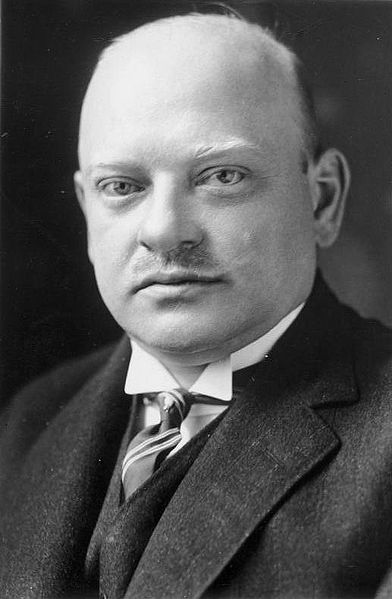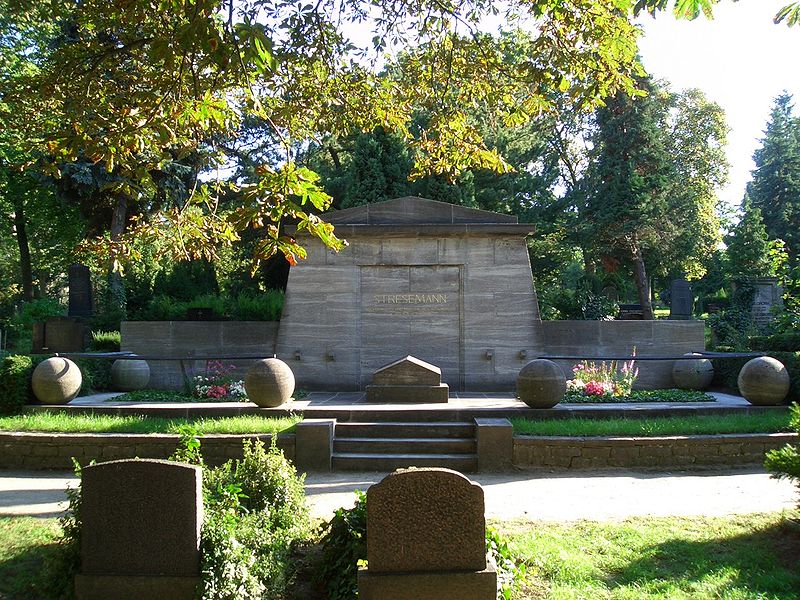<Back to Index>
- Political Economist Anne Robert Jacques Turgot, 1727
- Sculptor Carl Eldh, 1873
- Chancellor of Germany Gustav Stresemann, 1878


Gustav Stresemann (May 10, 1878 – October 3, 1929) was a German liberal politician and statesman who served as Chancellor and Foreign Minister during the Weimar Republic. He was co-laureate of the Nobel Peace Prize in 1926.
Stresemann's
politics defy easy categorization. Today, he is generally considered
one of the most important leaders of Germany and a staunch supporter of
democracy in the fragile Weimar Republic. Further, he is noted as one
of the first to envisage European economic integration. Arguably, his
most notable achievement was reconciliation between Germany and France,
for which he and Aristide Briand received the Peace Prize. Stresemann was born in Berlin. He came from middle class origins, as the son of a Berlin innkeeper and beer distributor. He attended the Universities of Berlin and Leipzig, studied philosophy and literature and received a doctorate in economics. He also became a spokesman for his student association. In 1902 he founded the Saxon Manufacturers'
Association. In 1903 he married Käthe Kleefeld (b.15. July 1885 in
Berlin; d. 1970 in New York City), daughter of a wealthy Jewish Berlin
businessman. At that time he was also a member of Friedrich Naumann's National-Social Association. In 1906 he was elected to the Dresden town council. Though he had initially worked in trade associations, Stresemann soon became a leader of the National Liberal Party in Saxony. In 1907, he was elected to the Reichstag,
where he soon became a close associate of party chairman Ernst
Bassermann. However, he disagreed with the most conservative party
members and lost his post in the party's executive committee in 1912.
Later that year he lost both his Reichstag and town council seats. He
returned to business and founded the German-American Economic
Association. In 1914 he returned to the Reichstag. He was exempted from
war service due to poor health. The evolution of his political ideas appears somewhat erratic. Initially, in the German Empire, Stresemann was associated with the left wing of the National Liberals. During World War I,
he gradually moved to the right, expressing his support of the monarchy
and Germany's expansionist goals. He was a vocal proponent of unrestricted submarine warfare. Stresemann briefly joined the German Democratic Party after
the war, but was expelled for his association with the right wing. He
then gathered most of the right wing of the old National Liberal Party
into the German People's Party (German: Deutsche Volkspartei, DVP), with himself as chairman. Most of its support came from middle
class and upper class Protestants. The DVP platform promoted Christian
family values, secular education, lower tariffs, opposition to welfare
spending and agrarian subsides and hostility to "Marxism" (that is, the Communists, and also the Social Democrats). The DVP was initially seen, along with the German National People's Party,
as part of the "national opposition" to the Weimar Republic,
particularly for its grudging acceptance of democracy and its
ambivalent attitude towards the Freikorps and the Kapp Putsch in
1920. By late 1920, Stresemann gradually moved to cooperation with the
parties of the left and center — possibly in reaction to political
murders like that of Walther Rathenau. However, he remained a monarchist at heart. On August 13, 1923, in the midst of the Ruhr Crisis,
he was appointed Chancellor and Foreign Minister of a grand coalition
government. As Chancellor, Stresemann went a long way towards resolving
the crisis. In the so-called year of crises (1923)
he showed strength by calling-off the popular passive resistance at the
Ruhr. Since Germany was no longer able to pay the striking workers,
more and more money was printed, which finally led to hyperinflation.
Hans Luther, who was the current finance minister, ended this
disastrous process by introducing a new currency, the Rentenmark, which reassured the people that the democratic system was willing and able to solve urgent problems. Stresemann's
decision to end passive resistance was motivated by his view that
Germany had to at least make a good faith effort to fulfill the terms
of Versailles. He, like virtually every German, felt Versailles was an
onerous Diktat that
sullied the nation's honor. However, he felt that by trying to fulfill
Versailles' terms, Germany could demonstrate that the reparations bill
was truly beyond its capacity. However, some of his moves - like his refusal to deal firmly with culprits of the Beer Hall Putsch -
alienated the Social Democrats. They left the coalition and arguably
caused its collapse on November 23, 1923. Stresemann remained as
Foreign Minister in the government of his successor, Centrist Wilhelm Marx.
He remained foreign minister for the rest of his life in eight
successive governments ranging from the centre-right to the centre-left. As Foreign Minister, Stresemann had numerous achievements. His first notable achievement was the Dawes Plan of 1924, which reduced Germany's overall reparations commitment and reorganized the Reichsbank. His second success was the Locarno Treaties with Britain, France, Italy, and Belgium, signed in October 1925 at Locarno. Germany officially recognized the post World War I western
border for the first time, and was guaranteed peace with France, and
promised admission to the League of Nations and evacuation of the last
Allied occupation troops from the Rhineland. Germany's eastern borders
were guaranteed to Poland only by France, not by a general agreement.
Stresemann was not willing to conclude a similar treaty with Poland:
"There will be no Locarno of the east" he said.
Moreover he never excluded the use of force to regain the eastern
territories of Germany which had come under Polish control as a
consequence of the Treaty of Versailles. The
reason were the atrocities against the German minority in the occupied
territories committed by or tolerated by the Polish government. In the session of the League of Nations on December 15, 1928 in Lugano Stresemann formulated a furious charge against Poland because of these crimes which were well known to the League of Nations. The chairman Aristide Briand,
French foreign minister, concluded the session after this speech with
the words: "The League of Nations must never break the sacred support
of the minority-rights.". After this reconciliation with the Versailles powers, Stresemann moved to allay the growing suspicion of the Soviet Union. The Treaty of Berlin signed in April 1926 reaffirmed and strengthened the Rapallo Treaty of 1922. In September 1926, Germany was admitted to the League of Nations as
permanent member of the Security Council. This was a sign that Germany
was quickly becoming a "normal" state and assured the Soviet Union of
Germany's sincerity in the Treaty of Berlin. Stresemann was co-winner of the Nobel Peace Prize in 1926 for these achievements. Germany signed the Kellogg-Briand Pact in
August 1928. It renounced the use of violence to resolve international
conflicts. Although Stresemann did not propose the pact, Germany's
adherence convinced many people that Weimar Germany was a Germany that
could be reasoned with. This new insight was instrumental in the Young Plan of February 1929 which led to more reductions in German reparations payment. Gustav
Stresemann's success owed much to his friendly personal character and
his willingness to be pragmatic. He was close personal friends with
many influential foreigners. The most noted was Briand, with whom he
shared the Peace Prize. Stresemann was not, however, in any sense pro-French. His main preoccupation was how to free Germany from the burden of reparations payments to Britain and France, imposed by the Treaty of Versailles. His
strategy for this was to forge an economic alliance with the United States.
The U.S. was Germany's main source of food and raw materials, and one
of Germany's largest export markets for manufactured goods.
Germany's economic recovery was thus in the interests of the U.S., and
gave the U.S. an incentive to help Germany escape from the reparations
burden. The Dawes and Young plans were the result of this strategy.
Stresemann had a close relationship with Herbert Hoover, who was Secretary of Commerce in 1921-28 and President from 1929. This strategy worked remarkably well until it was derailed by the Great Depression after Stresemann's death. During
his period in the foreign ministry, Stresemann came more and more to
accept the Republic, which he had at first rejected. By the mid-1920s,
having contributed much to a (temporary) consolidation of the feeble
democratic order, Stresemann was regarded as a Vernunftrepublikaner (republican
by reason) - someone who accepted the Republic as the least of all
evils, but was in their heart still loyal to the monarchy. The
conservative opposition criticized him for his supporting the republic
and fulfilling too willingly the demands of the Western powers. Along
with Matthias Erzberger and others, he was attacked as a Erfüllungspolitiker ("fulfillment politician"). In
1925, when he first proposed an agreement with France, he made it clear
that in doing so he intended to "gain a free hand to secure a peaceful
change of the borders in the East and [...] concentrate on a later
incorporation of German territories in the East". In the same year, while Poland was in a state of political and economic crisis, Stresemann began a trade war against
the country. Stresemann hoped for an escalation of the Polish crisis,
which would enable Germany to regain territories ceded to Poland after
World War I, and he wanted Germany to gain a larger market for its
products there. So Stresemann refused to engage in any international
cooperation that would have "prematurely" restabilized the Polish
economy. In response to a British proposal, Stresemann wrote to the
German ambassador in London: "[A] final and lasting recapitalization of
Poland must be delayed until the country is ripe for a settlement of
the border according to our wishes and until our own position is
sufficiently strong". According to Stresemann's letter, there should be
no settlement "until [Poland's] economic and financial distress has
reached an extreme stage and reduced the entire Polish body politic to
a state of powerlessness". Gustav Stresemann died of a stroke in
October 1929 at the age of 51. His massive gravesite is situated on the
Luisenstadt Cemetery at Südstern in Berlin Kreuzberg, and includes
work by the German sculptor Hugo Lederer. Stresemann's sudden and premature death, as well as the death of his "pragmatic moderate" French counterpart Aristide Briand in 1932, and the assassination of Briand's successor Louis Barthou in 1934, left a vacuum in European statesmanship that further tilted the slippery slope towards World War II.